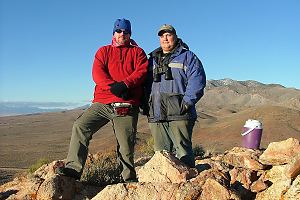 I arrived in Vegas on Friday 22 October and caught up with Joerg & Kim, Hank, TD Barnes and his wife for dinner. Hank made a new friend in the waitress who spilled food all over his pants and then proceeded to try to wipe it off!
I arrived in Vegas on Friday 22 October and caught up with Joerg & Kim, Hank, TD Barnes and his wife for dinner. Hank made a new friend in the waitress who spilled food all over his pants and then proceeded to try to wipe it off!
 I arrived in Vegas on Friday 22 October and caught up with Joerg & Kim, Hank, TD Barnes and his wife for dinner. Hank made a new friend in the waitress who spilled food all over his pants and then proceeded to try to wipe it off!
I arrived in Vegas on Friday 22 October and caught up with Joerg & Kim, Hank, TD Barnes and his wife for dinner. Hank made a new friend in the waitress who spilled food all over his pants and then proceeded to try to wipe it off!
The next day TD took us to Nellis, but there wasn't much action going on as crews and aircraft were preparing for the start of Red Flag 5-1-2, and we weren't able to get access to any ramp areas to photograph the jets. I spent the next few days catching up with members of the RAAF detachment in preparation for the article I would be writing, and praying for the weather to clear up.
I had originally planned to head out to the ranges from Vegas on Tuesday 26 October and camp out there for four or five nights, but the weather closed in on the Monday and dumped snow and rain all over the south-western US. With improving weather forecast for Friday the 29th, I decided to take my chances and head out on the Thursday morning.
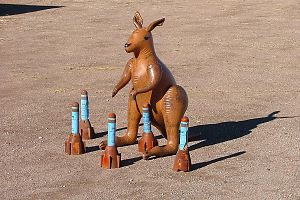 As I approached the pass at Hancock Summit which leads into Tikaboo Valley about 120km north of Vegas, the outside temperature gauge on my rental SUV indicated it was 23 degrees F, and intermittent passing snow falls forced me to pull over a few times. I finally reached Rachel and checked in with Jolene at the Quik Pick. I then headed out to Coyote Pass, some 15km south of Rachel in the hope that I would catch some of the afternoon flying action between passing snow showers, and was soon rewarded with two RAAF F-111s in about 60 second trail passing about a kilometre to my east at very low altitude on their ingress into the range. Soon after Karl joined me at Coyote and then Lone Wolf, but unfortunately, the rest of the afternoon was very quiet as everything had 'gone high' above the weather, and I was only able to catch the occasional glimpse of an F-16 or F-15 through breaks in the cloud.
As I approached the pass at Hancock Summit which leads into Tikaboo Valley about 120km north of Vegas, the outside temperature gauge on my rental SUV indicated it was 23 degrees F, and intermittent passing snow falls forced me to pull over a few times. I finally reached Rachel and checked in with Jolene at the Quik Pick. I then headed out to Coyote Pass, some 15km south of Rachel in the hope that I would catch some of the afternoon flying action between passing snow showers, and was soon rewarded with two RAAF F-111s in about 60 second trail passing about a kilometre to my east at very low altitude on their ingress into the range. Soon after Karl joined me at Coyote and then Lone Wolf, but unfortunately, the rest of the afternoon was very quiet as everything had 'gone high' above the weather, and I was only able to catch the occasional glimpse of an F-16 or F-15 through breaks in the cloud.
 Friday morning dawned a brilliantly clear, if still quite chilly day without a cloud in the sky. We headed back to the Coyote Pass carpark, packed our rucksacks, and embarked on the 30 minute, 500 foot hike up the hill just west of the highway. From there, we could see Bald Mtn and the northern end of the Groom Range to the south-west and west, the entire Tikaboo Valley to the south, Mt Irish and Student Gap to the east, and the Sand Spring Valley and Quinn Canyon Range to the north and north-west. From this prime vantage point, we were in prime position to see many of the ingressing and egressing blue force aircraft, both at low and high altitude. Chuck Clark arrived soon after and joined us on the hill.
Friday morning dawned a brilliantly clear, if still quite chilly day without a cloud in the sky. We headed back to the Coyote Pass carpark, packed our rucksacks, and embarked on the 30 minute, 500 foot hike up the hill just west of the highway. From there, we could see Bald Mtn and the northern end of the Groom Range to the south-west and west, the entire Tikaboo Valley to the south, Mt Irish and Student Gap to the east, and the Sand Spring Valley and Quinn Canyon Range to the north and north-west. From this prime vantage point, we were in prime position to see many of the ingressing and egressing blue force aircraft, both at low and high altitude. Chuck Clark arrived soon after and joined us on the hill.
The first sign of action was the start of a circular contrail to the east of us, perhaps 30-40 miles away. With the aid of binoculars, we identified the owner of the contrail as an E-3 AWACS as it established its orbit. Soon after, a number of parallel high level contrails were spotted headed our way from just south of the AWACS, but these soon disappeared as the aircraft either climbed or descended out of contrail altitude.
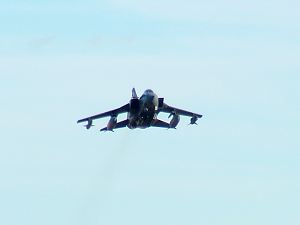 Our first close up view of any action occurred when a flight of four F-16 SEAD aircraft ventured up Tikaboo Valley at low altitude from the south and passed about 1km to the west of us before ingressing the range north of Bald Mtn. About 10 minutes later we spotted the shadow of a jet on the desert floor coming our way, but could not see the jet itself because it was so low and coming directly towards us. Suddenly it pulled up and revealed itself to be a Tornado GR.4 and flew directly over us barely 100 feet above the peak doing about 500kts. The Tornado ingressed the range through a square shaped notch in a ridge about 3 miles north-west of us, and its wingman followed about 30 seconds later and passed below our position about 500 metres to the east!
Our first close up view of any action occurred when a flight of four F-16 SEAD aircraft ventured up Tikaboo Valley at low altitude from the south and passed about 1km to the west of us before ingressing the range north of Bald Mtn. About 10 minutes later we spotted the shadow of a jet on the desert floor coming our way, but could not see the jet itself because it was so low and coming directly towards us. Suddenly it pulled up and revealed itself to be a Tornado GR.4 and flew directly over us barely 100 feet above the peak doing about 500kts. The Tornado ingressed the range through a square shaped notch in a ridge about 3 miles north-west of us, and its wingman followed about 30 seconds later and passed below our position about 500 metres to the east!
A number of rolling sonic booms soon echoed off the surrounding hills as a flight of F-15s flew over us at medium altitude heading north-east, and were subsequently engaged by aggressor F-16s lurking just inside range airspace. A furious twisting dogfight then ensued during which numerous flares were ejected and aircraft disengaged and then quickly re-engaged as they regained speed and altitude. It all ended after only a couple of minutes and both teams retreated to return to base or refuel.
A quiet period of about 20 minutes followed during which we only heard distant sonic booms or saw the occasional high flyer passing over, but we were soon treated to a gaggle of about eight A-10s egressing the range through the square notch. The first seven jets passed close to us on both sides of our hill, but the last jet rewarded us for our patience by doing a 90 degree turn around our hill only a few hundred metres away.
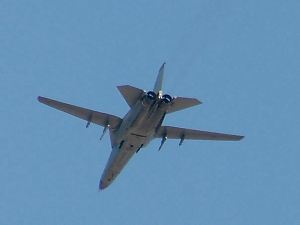 The rest of the action for that session consisted of a few more high flyers before things calmed down. The AWACS which had been orbiting for about 90 minutes and had built up an impressive concentric contrail pattern departed for Nellis to the south, which indicated the morning session was over.
The rest of the action for that session consisted of a few more high flyers before things calmed down. The AWACS which had been orbiting for about 90 minutes and had built up an impressive concentric contrail pattern departed for Nellis to the south, which indicated the morning session was over.
We spent the rest of the day exploring the area north of Rachel in the railroad Valley, before heading over to the Back Gate Rd adjacent to where it crosses into restricted territory to set up camp. We did see some action not related to Red Flag late in the afternoon when an F/A-22 from the OT&E detachment at Nellis was mixing it up with a couple of F-15s and F-16s above Flat Top at the western end of the Quinn Canyon Range. This time the furball went on for almost 10 minutes, and once again flares, hard manoeuvring, and re-engagements were the order. It was impossible to tell who was fighting who!
On the way to our campsite, we stopped to talk to a team who were operating one of the mobile Roland missile threats just south of Rachel, and were able to glean the callsign of theirs and some of the other mobile threats in the area. Once set up at camp, we tuned our scanner to their band and listened for the night sky to come alive.
 A full moon was rising on the eastern horizon as the night session got underway at about 9.40pm. The three of us were huddled around a camp fire in temperatures down around -10 degrees Celsius right next to the security gate into the ranges and the back road down to Groom Lake some 20km to the south.
A full moon was rising on the eastern horizon as the night session got underway at about 9.40pm. The three of us were huddled around a camp fire in temperatures down around -10 degrees Celsius right next to the security gate into the ranges and the back road down to Groom Lake some 20km to the south.
The first sign of action was the appearance of formation lights, or 'flashers' as we called them, approaching at high altitude and high speed from the east. Almost at the same time an aircraft popped through the square notch gap to the south east of us and hugged the northern end of the Groom Range before making a break across open ground to our south for the relative cover of Chalk Mtn. He was followed about 30 seconds later by a second low flyer, and through the binoculars we could barely make out the shape of what appeared to be swept back wings indicating it was either an F-111 or a Tornado.
The controller was soon on the air to advise the various mobile threats that there were aircraft in their vicinity, including their speeds, altitudes and bearings. It made it easy for us to pick up approaching aircraft we may have otherwise missed had we not had the scanner.
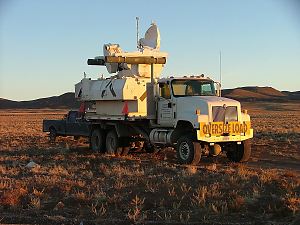 Not long after, a gaggle of high speed flashers ingressed from the east at medium altitude followed about a minute later by a line of slower and quieter aircraft at about 10 second intervals. Suddenly the scanner was alive again, this time with some mobile threats being told by the controller that they had been 'killed' by HARMs, so we were able to establish that the fast movers had probably been F-16C/D Weasels which had targeted the radar units, probably followed by Maverick and LGB toting A-10s to mop up.
Not long after, a gaggle of high speed flashers ingressed from the east at medium altitude followed about a minute later by a line of slower and quieter aircraft at about 10 second intervals. Suddenly the scanner was alive again, this time with some mobile threats being told by the controller that they had been 'killed' by HARMs, so we were able to establish that the fast movers had probably been F-16C/D Weasels which had targeted the radar units, probably followed by Maverick and LGB toting A-10s to mop up.
Next up was a spectacular dogfight a few kilometres to the north of us. Flares were being popped off everywhere turning night into day, jets were being kicked in and out of afterburner, and there seemed to be flashing lights and formation strips everywhere! The dogfight soon dissipated and for a few moments, the sky was quiet.
With the full moon providing some ambient light, I decided to scan the western horizon with my binoculars. As I scanned well inside the range, I noticed an aircraft egress through a pass about 15km away and turn straight towards us at low to medium altitude. The jet kept its afterburners on all the way and was soon followed by a wingman about 30 seconds in trail. As the first jet got closer I noticed it had two blue afterburner plumes streaming out the back, and as it passed over only a couple of thousand feet above us, the loudest whip crack of a sonic boom I had ever heard pierced the air and literally knocked us all to the ground! We all stood up laughing and cheering as we dusted ourselves off, and then braced ourselves waiting for the second jet to do the same, but thankfully he came out of burner just short of us and the sound barrier. That boom was a fitting Grande finale to the evening.
 The next day was a Saturday and was therefore a rest day for Red Flag. We decided to hike up to an area where we knew there to be an old crash site. The aircraft, an F-4D from Hill AFB in Utah had flown into a ridge on the northern slopes of the Groom Range at night during a Red Flag on 7 March 1979 with the loss of its crew.
The next day was a Saturday and was therefore a rest day for Red Flag. We decided to hike up to an area where we knew there to be an old crash site. The aircraft, an F-4D from Hill AFB in Utah had flown into a ridge on the northern slopes of the Groom Range at night during a Red Flag on 7 March 1979 with the loss of its crew.
We parked Karl's F150 at the bottom of a barely marked road which looked a little too wild to take on, and Lone Wolf shuttled us the rest of the way in his 4WD to a point just below the snowline. The 2-3 mile hike to the crash site took about half an hour where we came across the first bit of debris, an inert 500lb Mk-82 Snakeye bomb. The bomb was near the bottom of a wash, and as one of our party had previously hiked to the crash site and knew the bomb to be at the far or western end of the debris field, we started tracking east up a ridge until we came across more small bits and pieces including engine casings, generators and avionics racks.
Once up on top of the ridge on a small plateau the full force of the impact became evident. There spread out before us in a line over about a mile to the next ridge were large and small pieces of aircraft debris, some glinting in the sun, and others painted but large enough to recognise as bits of wing, fuselage or tail.
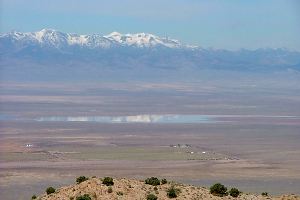 Pretty soon we noticed we were being watched by the ever vigilant Groom Lake border guards, known locally as the 'Cammo Dudes'! They parked on a small hill about a mile away from us and remained in their truck so they could observe our progress, but we were several hundred yards outside the (unmarked!) restricted area and had little to worry about. Still, we kept checking the GPS just in case!
Pretty soon we noticed we were being watched by the ever vigilant Groom Lake border guards, known locally as the 'Cammo Dudes'! They parked on a small hill about a mile away from us and remained in their truck so they could observe our progress, but we were several hundred yards outside the (unmarked!) restricted area and had little to worry about. Still, we kept checking the GPS just in case!
The breathtaking scenery of the high desert was really something to behold, and we took time out to rest and take it all in. Fortunately, because the exact location of the site isn't publicised and is relatively inaccessible, few pieces of the aircraft have been taken over the years, and the site remains relatively intact. When it was time to start our hike down, no souvenirs from the crash were taken out of respect to the crew.
Although it was shortened by the weather, it was another great visit out to Rachel and the surrounding areas. Look forward to seeing you guys again next year!